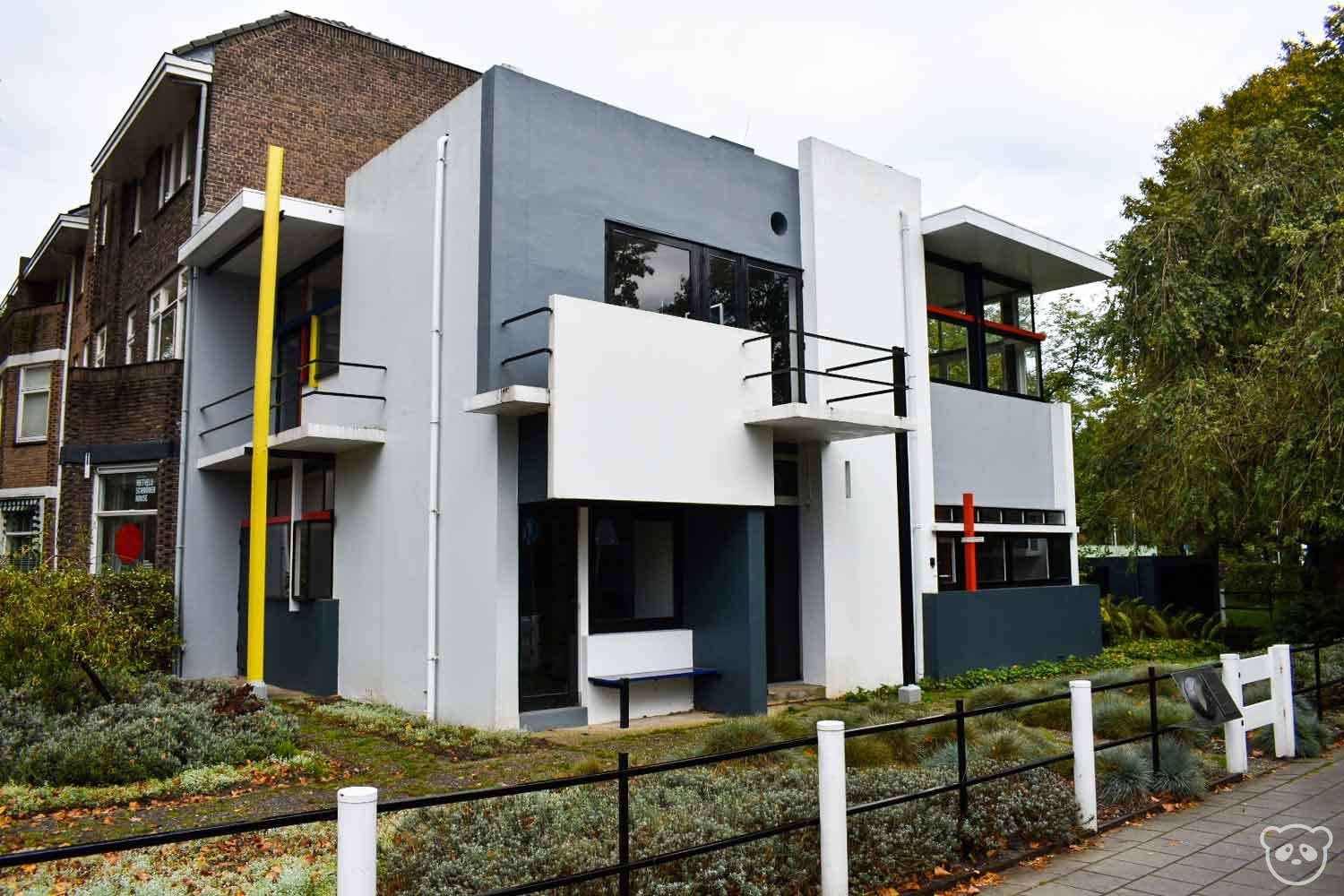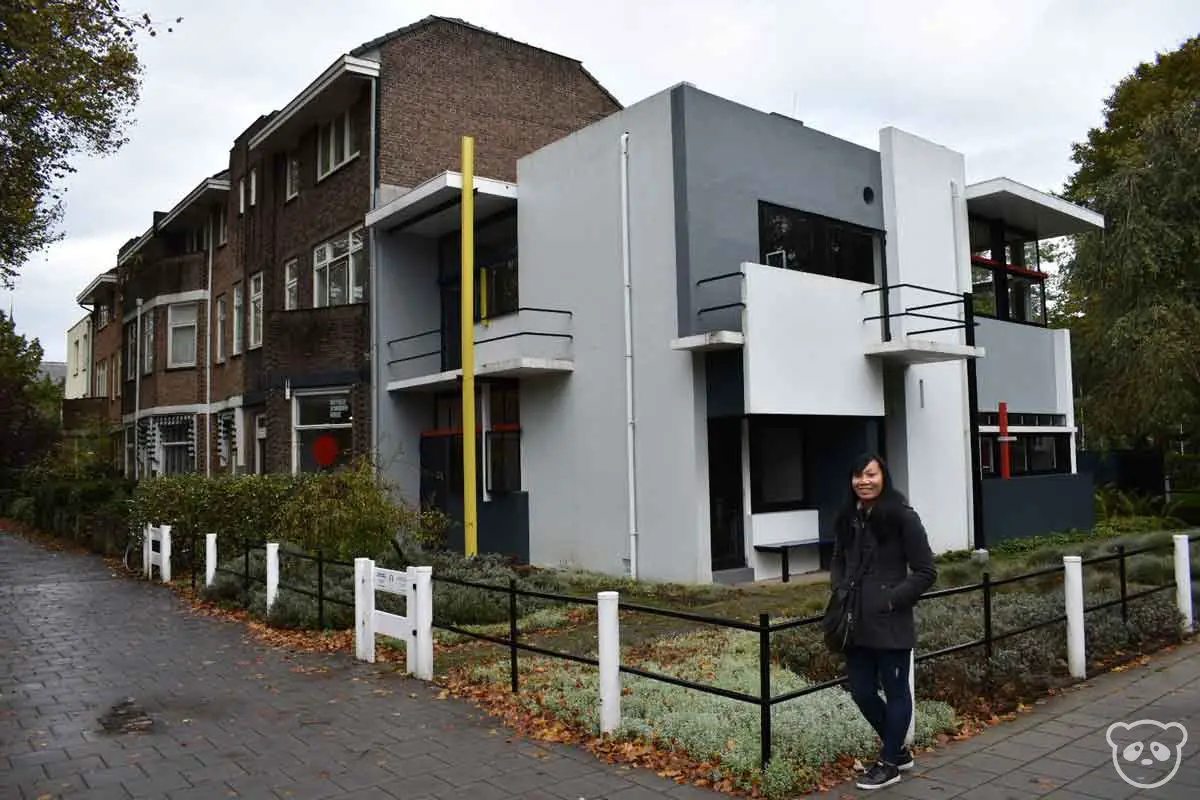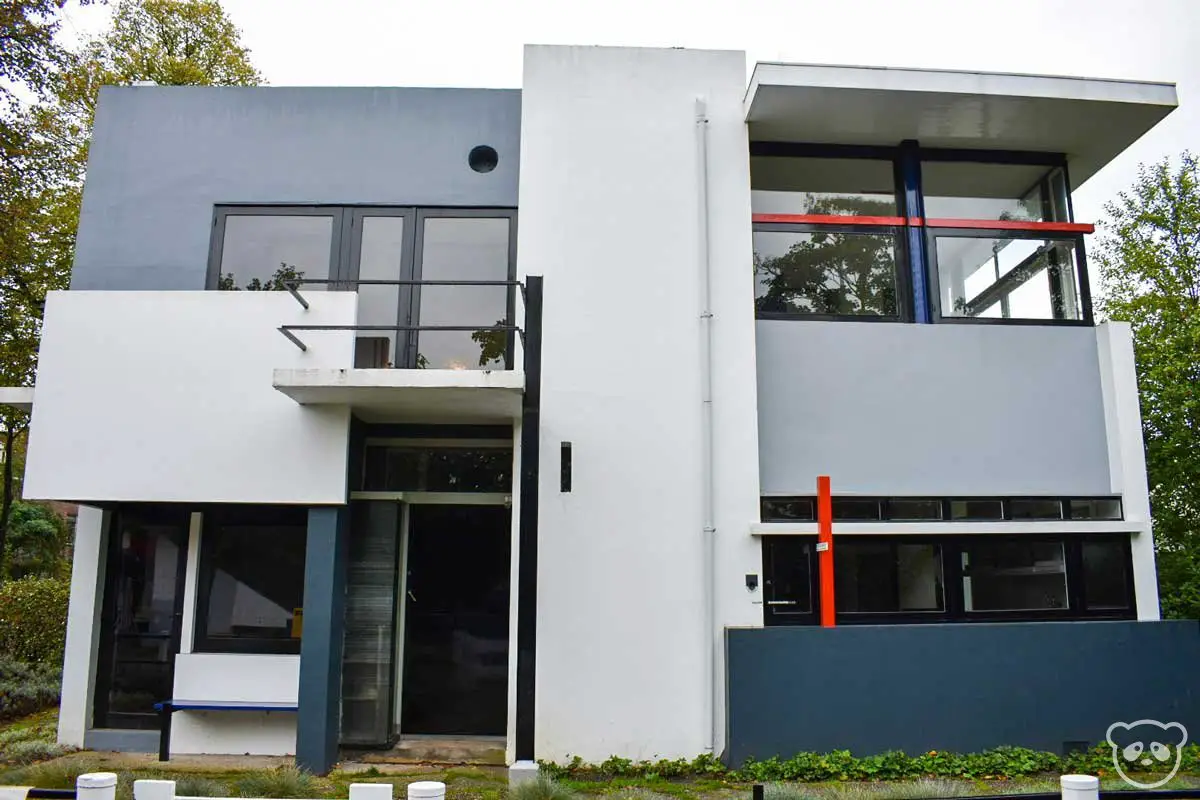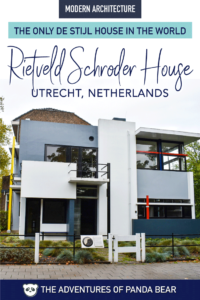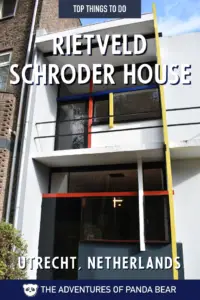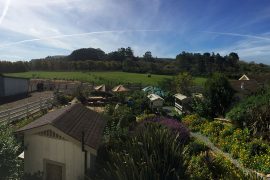Rietveld Schröder House aka Schröder House (Dutch: Rietveld Schröderhuis) is one of the most iconic and recognizable houses in modern architecture. From its neutral gray and black tones, to its use of primary colors and strong angles, its design is the epitome of modern, even today the home looks as contemporary as ever. Better yet, Utrecht is a great place for a day trip from Amsterdam.
Fun Fact: The Rietveld Schröder House has been a listed national monument since 1976 and was designated a UNESCO World Heritage site in 2000.
Compared to many houses of the era, the Rietveld Schröder House had many architectural innovations that were ahead of its time. Its design is truly unlike any of its predecessors.
Knowing all of these cool things about the house, when we got a chance to visit The Netherlands, specifically Utrecht, we jumped at the opportunity to take a tour of the Rietveld Schröder House. We learned so much about the partnership between Rietveld and Schröder during the design and construction as well as afterwards.
The Vision
“[She wanted] simplicity and a space that freed rather than constrained her.” (Rietveld Schröder House)
In 1924, Truus Schröder, a Dutch socialite, asked Utrecht architect, Gerrit Rietveld to design a house for herself and her family. The recently widowed mother of 3 wanted an unconventional home designed especially for her and her needs. She also wished for her new home to have a connection between the inside and outside.
Fun Fact: Prior to this home, Gerrit Rietveld had only designed furniture and scale models. It was the first house he’d ever built.
Like Schröder, Gerrit Rietveld was not a fan of the traditional and for this reason it was a dream project for him. He was able to use all of the principles of De Stijl movement.
“De Stijl” (The Style)
The De Stijl (also known as Neo-Plasticism) art movement was founded in 1917 in the Netherlands by a group of artists and architects. Some of the important members included Theo van Doesburg, Piet Mondrian, and of course, Gerrit Reitveld. The “De Stijl” name came about from the journal written by Theo van Doesburg spreading the ideas of the group’s theories.
“This new plastic idea will ignore the particulars of appearance, that is to say, natural form and colour. On the contrary, it should find its expression in the abstraction of form and colour, that is to say, in the straight line and the clearly defined primary colour”. – Piet Mondrian from “Neo-Plasticism in Pictorial Art”
The fundamental principles of De Stijl emphasized the use of straight lines and primary colors. This meant that many works of art created in De Stijl style included geometric shapes such as square and rectangular forms in pure primary colors, gray, white, and black.
Fun Fact: The Rietveld Schröder House was the only building built completely using De Stijl principles.
The planar construction of the house was built using reinforced concrete slabs, steel beams, and brick & plaster walls. The doors, window frames, & walls were wooden.
Fun Fact: Originally, Gerrit Rietveld wanted to complete the entire house in concrete but it was too expensive for such a small house.
Exterior
From the outside, you can easily see that the Rietveld Schröder House was built using rectangles and De Stijl colors and the house is the embodiment of it. The house is angular with clean, straight lines and is mainly neutral toned with primary colors as accents.
Fun Fact: The front door is painted black because it is utilized heavily and would therefore be most easily soiled.
Large windows, especially upstairs, brought the outside closer to the inside, per Schröder’s request. The balconies on the outside also allowed the family to enjoy the outdoors.
Interior
Ground (1st) Floor
The ground floor of the house is more typical of that era in that the individual rooms are more closed off and “traditional.” It consists of a kitchen and 3 rooms, all arranged around the staircase. The three rooms include a reading room, studio, and bedroom. There is also a multi-use room that can be considered a kitchen, living, and dining room. Adjacent to the studio and bedroom is a working space. And next to the front door is a bathroom.
But this by no means defines even the first floor as a “traditional” home, there are several noteworthy innovations that are still modern today.
Unique & Innovative Design Features
Removable Shutters
Throughout the house, there are removable shutters that are black outside, blue inside to match the window frames. This makes the windows look solid black while outside.
Wondering how they work? Watch the video below!
Hinged Windows
To maintain the strict De Stijl design standards, all of the windows are hinged to open up to 90 degrees. This kept the intersecting plane ideals intact and the windows are perpendicular to the house .
Collapsible Tables
These tables are located on both floors of the house. They allowed the Schröder family to make use of their space. The tables would easily be set up if needed and put away when not in use. Rietveld also designed a child-sized table specifically for Schröder’s children.
Hidden Staircase
In the hallway of the ground floor, you can see a few steps. These are the beginning of the staircase. From the hallway, there is a red lever that can be pushed to open a sliding door to reveal the stairs.
Check out the red lever in action!
Upstairs, the door has an extended handle to slide it closed without needing to walk downstairs to the door. After sliding it the door closed, the stairwell could be built up to enclose itself from the upstairs space. This feature also helped keep the house warm during chilly winters.
Second Floor
This portion of the house is one of the most unique of all and was the primary living space used by Schröder and her three children. The second floor consisted of bedrooms and storage space that could be altered into an open play area during the day.
Schröder had a few requirements for this floor:
- The children’s beds had to fit into their rooms in 2 different positions
- Each room should have their own access to water and drainage
- All rooms need to have their own outdoor access (balcony)
Rietveld included those and more in his architectural design for the upstairs area.
Unique & Innovative Design Features
Movable Walls
The sliding walls are one of the coolest aspects of the home. This allowed Schröder’s children to play and hang out in the open space during the day. At night, the entire floor transformed into private bedrooms just by sliding the walls out.
See these walls in action!
Cornerless Window
This window on second floor facing Prins Hendriklaan is the famous window that can be opened completely leaving no corner seam. It is one of the most innovative features of the house and allowed Schröder to get an amazing view of trees and plants that once existed just outside the window.
The corner disappears before your eyes!
Speaking Tube
Schröder loved her view from the cornerless window on the second floor, she found it very relaxing. Rietveld designed a speaking tube through which she could talk to visitors without having to leave her favorite spot.
The following video discusses some of the innovations inside and outside the home. But of course you can always see it for yourself, in real life, through a tour of the Rietveld Schröder House.
After Completion
The house was completed in 1925. Schröder and Rietveld’s partnership continued afterwards, she gave him a room downstairs to use as a studio. There he worked on new designs and in 1957, he even moved into the house after his wife’s death. He lived there until his own death in 1964.
Fun Fact: When the Rietveld Schröder House was built, the area was relatively undeveloped and located at the outskirts of Utrecht. The large cornerless window once opened to a beautiful view of greenery. Schröder even went as far as purchasing the land across the street in the 1930s to prevent her view from becoming “ruined.” But in the 1960s, a 4 lane motorway and viaduct were built in the front yard, and Rietveld felt that the house should be torn down since the link between the outside and inside was gone.
Schröder lived there until her death in 1985, she left the house under the management of the Rietveld Schröder House and the Centraal Museum in Utrecht.
Fun Fact: At one point there was an additional staircase leading to the roof, where Schröder escaped the crowds. Once the home became a popular destination, visitors would come by and look at the house. Today, this addition to the house has been torn down.
Visiting Information
Timed Admission
€17 for adults (age 18+)
€9 for students and minors (aged 13-17 years) and CJP pass holders
€8.50 for U-pas
€3 for children (aged 12 years or younger), CM-club, Museumkaart, & Rembrantkaart pass holders
Any discount cards and passes will be checked for validity on-site.
The cost of admission includes an audio guide which is available in English, Dutch, German, French, Italian, Spanish, Japanese and Mandarin. This audio guide tour takes approximately 1 hour.
Tickets to the Rietveld Schröder House also include same-day admission to the Centraal Museum.
Note: Admission is limited to a maximum of 12 people and advanced bookings for timed tickets are required.
Tickets can be purchased here.
Ticket Times
Daily 11:00am, 12:00pm, 2:00pm, 3:00pm, 4:00pm
Peak Season Extended Hours (April – September only): Fridays 5:00pm, 6:00pm, 7:00pm, 8:00pm
Hours
Tuesdays through Sundays 11:00am-5:00pm
Closed on Mondays
Helpful Tips
- Shoe covers are provided and must be worn inside the house.
- Strollers and wheelchairs are not allowed inside.
- Bags and purses are not permitted inside the house, lockers are provided inside the ticket office.
Directions & Getting There
Address
Prins Hendriklaan 50
3583 EP Utrecht, Netherlands
Website
When you arrive, check in at the ticket office, located next to the Schröder House at Prins Hendriklaan 50a. They will double check your name and you will wait there for your tour to start.

